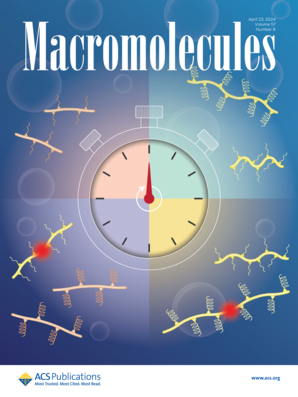Cyclization of Polyacrylonitrile Nanofibers Enhanced by Cu2O During Electrospinning
IF 5.1
1区 化学
Q1 POLYMER SCIENCE
引用次数: 0
Abstract
This work uncovers a novel room-temperature cyclization pathway for polyacrylonitrile (PAN), facilitated by copper(I) oxide (Cu2O) during electrospinning, paving the way for advanced material design of functional materials. Cyclization, traditionally requiring temperatures around 290 °C, is an essential step in carbon fiber production and the development of advanced functional materials. We demonstrate that thermal pretreatment and the incorporation of Cu2O enable partial cyclization at ambient conditions, leading to the formation of nonaromatic structures such as azine and imine derivatives during electrospinning. The catalytic role of Cu2O in influencing cyclization is confirmed by dedicated analytical studies showing a significant extent in its presence. Solid-state nuclear magnetic resonance spectroscopy (ssNMR) and Fourier-transform infrared spectroscopy (FTIR) reveal the chemical transformations induced by high-voltage during electrospinning, emphasizing the interplay between solution preparation, selection of catalysts, and electrospinning conditions. These findings highlight the significance of metal oxides in tailoring polymer chemistry within fiber structures and provide a foundation for exploring alternative catalysts to design nanofiber electrodes optimized for energy conversion applications.

静电纺丝过程中Cu2O增强聚丙烯腈纳米纤维的环化
本研究揭示了聚丙烯腈(PAN)在静电纺丝过程中由氧化铜(Cu2O)促进的一种新的室温环化途径,为功能材料的先进材料设计铺平了道路。传统上需要290°C左右的温度进行环化,这是碳纤维生产和先进功能材料开发的重要步骤。我们证明了热预处理和Cu2O的加入可以在环境条件下实现部分环化,导致静电纺丝过程中形成非芳香族结构,如azine和亚胺衍生物。专门的分析研究证实了Cu2O在影响环化中的催化作用,表明它的存在程度很大。固体核磁共振光谱(ssNMR)和傅里叶变换红外光谱(FTIR)揭示了静电纺丝过程中高压引起的化学转变,强调了溶液制备、催化剂选择和静电纺丝条件之间的相互作用。这些发现突出了金属氧化物在纤维结构中裁剪聚合物化学的重要性,并为探索替代催化剂来设计优化能量转换应用的纳米纤维电极提供了基础。
本文章由计算机程序翻译,如有差异,请以英文原文为准。
求助全文
约1分钟内获得全文
求助全文
来源期刊

Macromolecules
工程技术-高分子科学
CiteScore
9.30
自引率
16.40%
发文量
942
审稿时长
2 months
期刊介绍:
Macromolecules publishes original, fundamental, and impactful research on all aspects of polymer science. Topics of interest include synthesis (e.g., controlled polymerizations, polymerization catalysis, post polymerization modification, new monomer structures and polymer architectures, and polymerization mechanisms/kinetics analysis); phase behavior, thermodynamics, dynamic, and ordering/disordering phenomena (e.g., self-assembly, gelation, crystallization, solution/melt/solid-state characteristics); structure and properties (e.g., mechanical and rheological properties, surface/interfacial characteristics, electronic and transport properties); new state of the art characterization (e.g., spectroscopy, scattering, microscopy, rheology), simulation (e.g., Monte Carlo, molecular dynamics, multi-scale/coarse-grained modeling), and theoretical methods. Renewable/sustainable polymers, polymer networks, responsive polymers, electro-, magneto- and opto-active macromolecules, inorganic polymers, charge-transporting polymers (ion-containing, semiconducting, and conducting), nanostructured polymers, and polymer composites are also of interest. Typical papers published in Macromolecules showcase important and innovative concepts, experimental methods/observations, and theoretical/computational approaches that demonstrate a fundamental advance in the understanding of polymers.
 求助内容:
求助内容: 应助结果提醒方式:
应助结果提醒方式:


